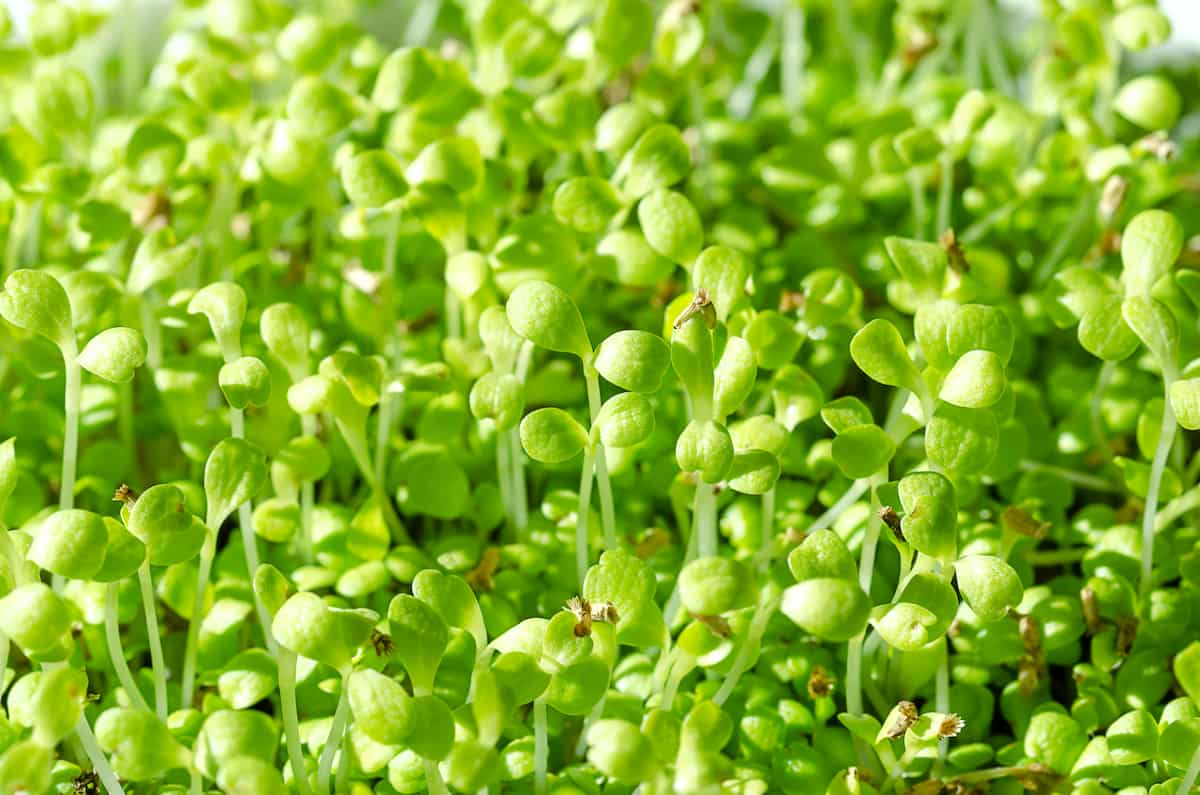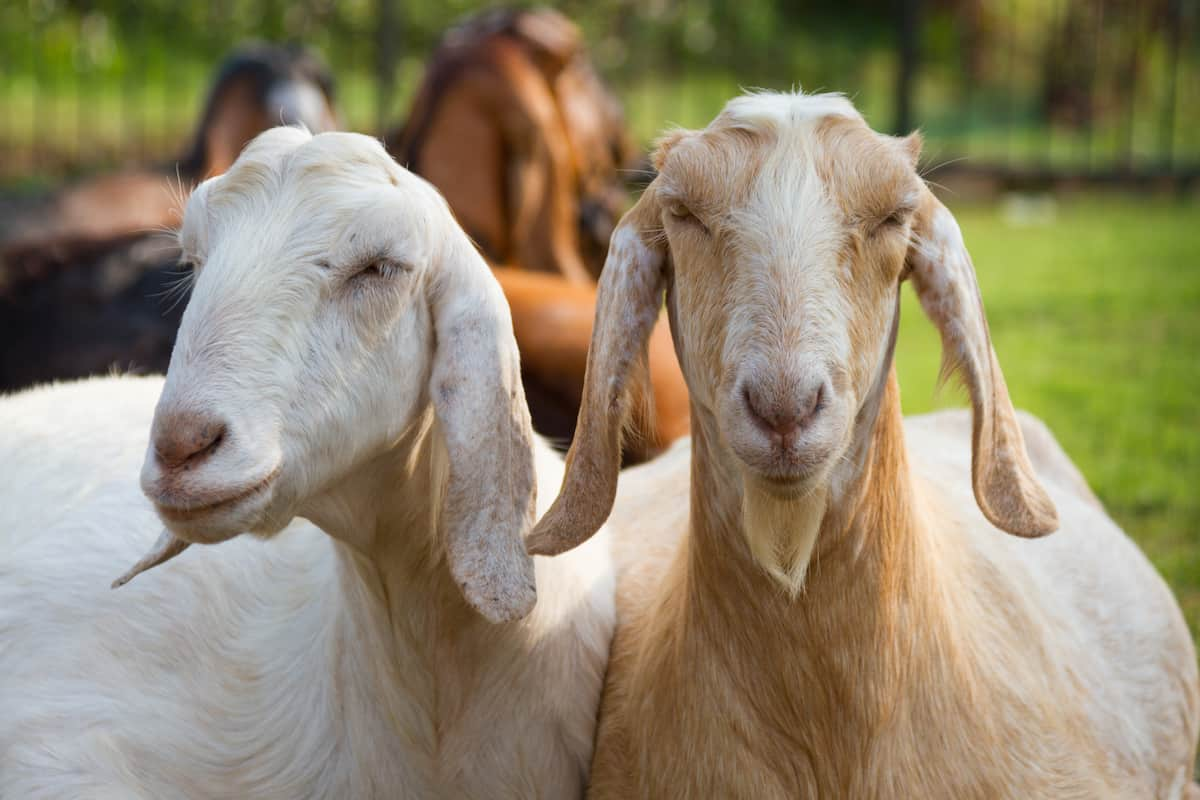In recent years, using microgreens as a nutritious and sustainable feed source for livestock has gained popularity among farmers and researchers. Microgreens are young, tender, edible plants harvested at the cotyledon or first true leaf stage. They are known for their high nutritional content, rapid growth, and low-resource requirements. Below we learn the benefits and applications of microgreens as a feed source and fast-growing plants, fodder feeding systems for cattle, goats, sheep, rabbits, and pigs.

Feeding Livestock With Microgreens
Benefits of Feeding Livestock Microgreens
- Nutritional value: Microgreens are rich in vitamins, minerals, proteins, and antioxidants, providing livestock with essential nutrients for optimal health and growth. They often contain higher concentrations of nutrients compared to their mature counterparts.
- Sustainable production: Microgreens can be grown year-round, indoors or outdoors, using minimal water, space, and energy. This makes them an environmentally friendly and cost-effective alternative to traditional feed sources.
- Enhanced palatability: Livestock often find microgreens more palatable than other types of feed, leading to increased feed intake and overall animal performance.
Microgreens for Cattle
- Suitable varieties: Cattle can benefit from various microgreens, including alfalfa, barley, wheatgrass, and sunflower. These species are high in protein, energy, and fiber, essential for cattle growth, maintenance, and milk production.
- Feeding methods: Microgreens can feed cattle as fresh or dried fodder. Fresh microgreens should be harvested when the plants are 1-3 inches tall and fed directly to the animals. Alternatively, microgreens can be dried and mixed with other feed components such as silage, hay, or concentrates.
- Benefits: Feeding microgreens to cattle has been shown to improve milk production, quality, and composition, as well as support overall animal health.
Microgreens for Goats:
- Suitable varieties: Goats can thrive on a diet that includes microgreens such as clover, alfalfa, and radish. These species are rich in protein, fiber, and minerals like calcium and phosphorus, essential for bone development and overall health.
- Feeding methods: Microgreens can be fed to goats as fresh fodder or mixed with other feed components like hay and concentrates. Fresh microgreens can be chopped and mixed with other feeds or offered as a separate component in the diet.
- Benefits: Incorporating microgreens into goats’ diets can improve milk production, increase weight gain, and improve overall health.
In case you missed it: How to Start a Livestock Feed Production: A Profitable Agriculture Business

Microgreens for Sheep
- Suitable varieties: Sheep can benefit from alfalfa, clover, and mustard microgreens. These species are high in protein, energy, and essential nutrients for growth, reproduction, and wool production.
- Feeding methods: Microgreens can be fed to sheep as fresh fodder, dried, or mixed with other feed sources like hay and concentrates. Fresh microgreens can be offered as a supplement to the regular diet or as a primary feed source during periods of limited grazing.
- Benefits: Feeding microgreens to sheep can result in improved weight gain, wool production, and overall health.
Microgreens for Rabbits
- Suitable varieties: Rabbits can thrive on various microgreens, including broccoli, kale, spinach, and pea shoots. These species are rich in fiber, vitamins, and minerals essential for maintaining healthy digestion and overall well-being.
- Feeding methods: Microgreens can be fed to rabbits as a fresh supplement to their regular diet. It is important to offer a mix of microgreens to ensure a balanced and diverse nutrient intake. Fresh microgreens can be scattered on the regular hay or mixed with other vegetables in the rabbits’ diet.
- Benefits: Feeding microgreens to rabbits can promote better digestion, reduce the risk of gastrointestinal issues, and improve overall health and vitality.
In case you missed it: Frequently Asked Questions About Rabbit Farming

Microgreens for Pigs
- Suitable varieties: Pigs can benefit from microgreens such as barley, wheatgrass, sunflower, and field peas. These species are high in protein, energy, and essential nutrients, which support growth, reproduction, and overall health.
- Feeding methods: Microgreens can be fed to pigs as fresh fodder, dried, or mixed with other feed sources like grains and vegetables. Fresh microgreens can be chopped and mixed with other feed components or offered separately in the diet.
- Benefits: Incorporating microgreens into pigs’ diets can improve weight gain, feed efficiency, and overall health.
Challenges and Considerations
While microgreens offer numerous benefits as a livestock feed source, there are some challenges and considerations to keep in mind:
- Production scale: To meet the nutritional needs of many animals, a considerable volume of microgreens must be produced. This may require substantial investment in infrastructure, equipment, and labor.
- Consistent quality and supply: Ensuring a consistent supply of high-quality microgreens can be challenging, particularly in areas with extreme weather conditions or limited access to resources like water and electricity.
- Potential anti-nutritional factors: Some microgreens may contain anti-nutritional factors, such as oxalates or glucosinolates, which can negatively affect animal health when consumed in large quantities. It is essential to carefully select and monitor the species and varieties used in livestock feeding.
Future Prospects
As the demand for sustainable and nutritious feed sources for livestock continues to grow, microgreens hold significant potential as a viable alternative to traditional feedstuffs. Ongoing research and development in this area are essential to optimize microgreens production methods, identify the most suitable species and varieties for different livestock species, and establish feeding guidelines and best practices.
Implementing Microgreens Production on the Farm
- Selecting a growing system: Farmers can choose from various growing systems, including vertical farming, hydroponics, or traditional soil-based methods. The choice depends on the available space, resources, and specific requirements of the microgreens species being grown.
- Planning production: To ensure a consistent supply of microgreens, it is essential to plan a continuous production cycle, accounting for germination, growth, and harvest times for each variety. This will help maintain a regular supply of fresh microgreens for the livestock.
- Pest and disease management: As with any agricultural endeavor, pests and diseases can challenge microgreens production. Integrating pest management strategies, such as proper sanitation, crop rotation, and biological control agents, can help prevent and manage these issues.
Conclusion
Microgreens offer an exciting opportunity to improve livestock feed’s sustainability and nutritional quality while enhancing animal health and performance. By adding microgreens to the diets of cattle, goats, sheep, rabbits, and pigs, farmers can support the well-being of their animals and reduce their reliance on traditional feed sources.
- Feed Your Flock for Less: Top 10 Tips to Save on Chicken Feed
- Ultimate Guide to Ossabaw Island Hog: Breeding, Raising, Diet, and Care
- Hatching Answers: The Top 10 Reasons Your Chickens Aren’t Laying Eggs
- Eggs and Economics: Breaking Down the Cost of Raising Backyard Chickens
- Defend Your Greens: Proven Methods to Keep Iguanas Out of Your Garden
- Ultimate Guide to Cinnamon Queen Chicken: A Comprehensive Guide for Beginners
- Ultimate Guide to California Tan Chicken: Breeding, Raising, Diet, Egg-Production and Care
- Ultimate Guide to Marsh Daisy Chicken: Breeding, Raising, Diet, and Care
- 10 Types of Chicken Farming Businesses You Can Start for Profits